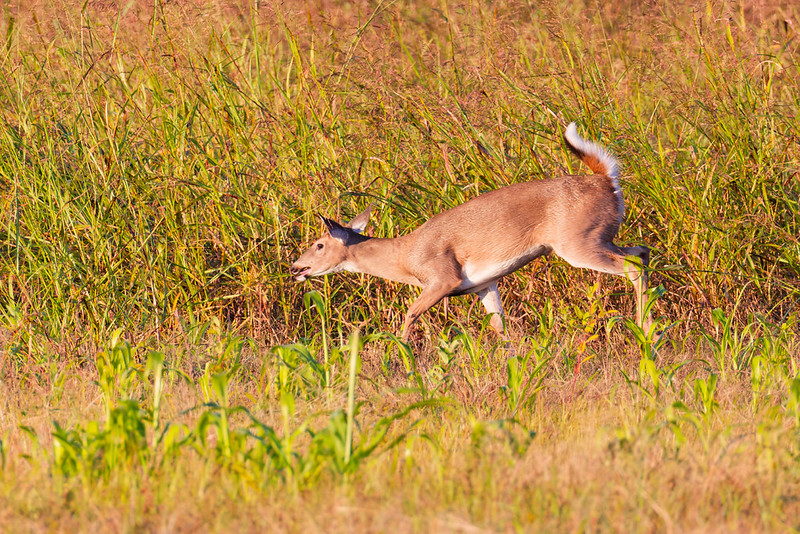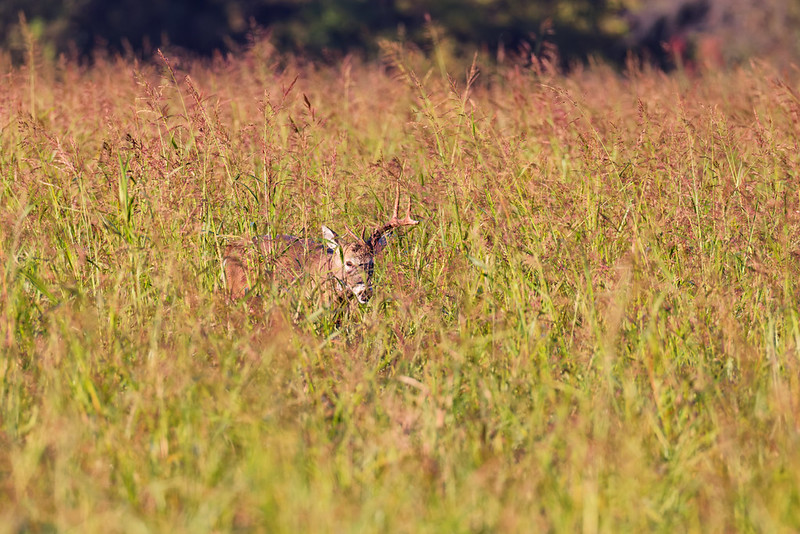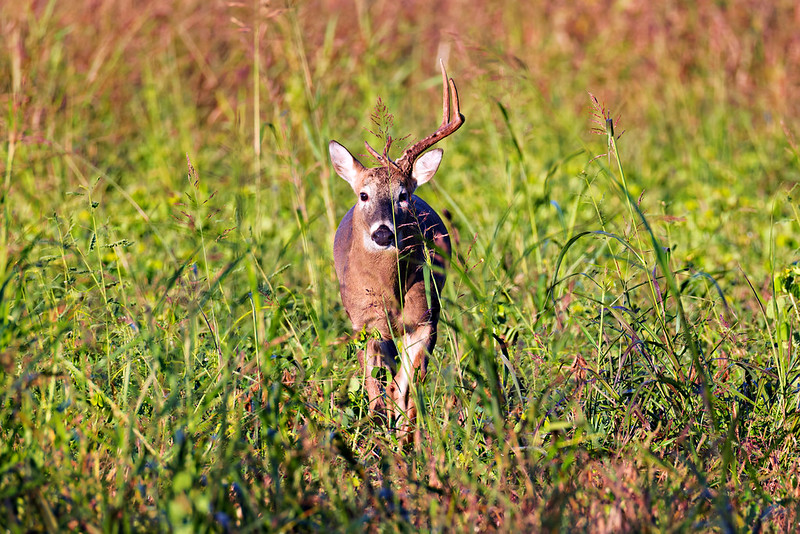I was driving the auto tour road at Sequoyah National Wildlife Refuge on the morning of November 5th when I got a text from another photographer, Mia McPherson. She told me she had spotted a large white-tailed buck chasing a doe. She gave me the location, and I drove over to find two bucks in the back of a field.
A utility road was nearby. I parked and walked toward the back of the field near the treeline. I spotted several white-tailed does running back and forth in another field on the other side of the trees. One doe was by herself, breathing hard with her tongue hanging out. I decided she was the one being pursued by the bucks, and I would watch her.

Setting Up for the Shot During the White-Tailed Buck Rut
At one point she ran past me on the road. I got my camera ready, hoping to photograph the buck that was chasing her. The deer were in an overgrown field. I saw the doe running through an opening in the weeds and decided I would set up near that spot, hoping the buck would pass through the same area.
The problem was that I was standing on the road, and the opening was close to where I was. I did have the wind in my favor. I hoped the buck would be so focused on locating the doe that he would not see me.
White-Tailed Buck With One Antler on the Doe’s Trail

A few minutes later I spotted a buck trotting through the tall weeds, heading in my direction. He was on the trail of the doe, and it appeared he would pass through the clearing near where I was set up. I got ready, holding my camera and lens in the shooting position so the buck would not see me move. He was on the same path the doe had taken. When he got close I was able to get a few good photos without him knowing I was nearby.

This buck turned out to have a unique antler on one side and no indication of an antler on the other side. It seemed to me that no antler ever grew on that side of his head. I could see that it had not been broken off, which sometimes happens when bucks fight with other bucks during the rut.

Wildlife Notes
White-tailed bucks chase does during the breeding season, which typically peaks in November across much of Oklahoma and Arkansas. Bucks will pursue does for hours, sometimes covering several miles in a single day. The doe I observed appeared exhausted, which is common when a buck is persistent.
This buck’s single-antler condition is unusual but not unheard of. Antler growth can be affected by injuries to the pedicle (the bony base where antlers grow), damage to the skull during fawn development, or hormonal imbalances. In this case, the missing antler side showed no sign of breakage or shedding, suggesting the antler never developed. Bucks with asymmetrical antlers can still compete during the rut, though they may be at a disadvantage in sparring matches with other males.
The overgrown fields at Sequoyah National Wildlife Refuge provide excellent cover for deer during the rut. Tall grasses and weeds allow does to evade bucks temporarily, while bucks use the same cover to approach undetected. The refuge’s mix of open fields, tree lines, and utility roads creates natural travel corridors that make it easier to predict deer movement.
Photography Notes
I photographed this white-tailed buck with one antler using my Canon EOS R5 with the Canon RF 200-800 mm lens. I was shooting handheld from the utility road, which gave me a stable position and a clear view of the field. The wind was in my favor, blowing my scent away from the deer.
I used a shutter speed of 1/2000 second to freeze the buck’s movement as he trotted through the field. The aperture was set to f/9 to keep enough depth of field while maintaining good sharpness on the subject. ISO was 1600, which was necessary for the early morning light conditions. I applied -2/3 exposure compensation to preserve detail in the highlights, particularly on the buck’s coat and the bright grasses.
The focal length of 570 mm allowed me to fill the frame without getting too close and spooking the deer. Shooting handheld gave me the flexibility to track the buck as he moved through the clearing.
Closing Thoughts
You may also like my earlier post about another buck chasing a doe at this same refuge: Close Encounter: Photographing a Rutting Buck
It was great to have a plan come together so that I could get a few photos of this whitetail buck with one antler without disturbing him while he was in hot pursuit of a doe.
Author’s Note:
After reviewing the photos again, I noticed a small ½-inch antler stub on the side that first appeared antlerless. This suggests the buck did start growing an antler on that side. The stub was hidden by the angle and tall weeds during the encounter, so I did not see it in the field.
